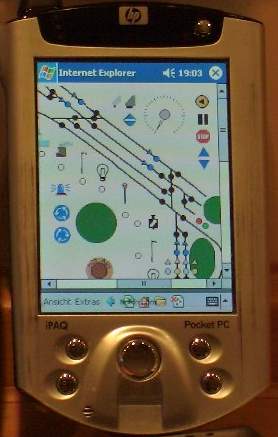A wireless panel-operated signal box for the vest pocket
in the form of a handheld probably is the most elegant variant of controlling a garden railway. When you first look at it, the railway's simple operation by clicking around on the screen in your hand and the almost boundless freedom of movement without a cable are the most interesting advantages.The decision against one of the established digital control systems was made because of the acquisition costs of all components and because of the known design flaws of each particular system as well as the control stations, partially having an archaic charm.
Paying a little fortune for a digital conversion of the whole rolling stock and other devices appeared to make very little sense, given the fact one would get a numeric keypad in return for throwing a particular turnout or moving a dedicated locomotive by typing some numerical codes.
Controlling analogue components
on a wireless basis with a maximum of comfort was declared the goal to be reached of the system introduced here. In addition, implementation and follow-up costs had to be significantly less in comparison to a conventional digital system.Within the scope of investments' protection, only commercial components and parts which could be replaced by parts from any other manufacturer were selected.
Furthermore, an eye was kept on that there was no need for modifications of any present or future materials (f.i. locos one will buy some time later). Any analogue consumer (turnout, signal, illumination, function model...) or vehicle had to be operable without conversion or additional add-ons with this control system by a "click".
The development's result
is a system which - regarding its functionalities - compares very well to the established digital systems.This me-too-product's significant advantages are its flexibility, its interfaces and its ergonomical friendlyness as well as all its components' configuration possibilities.
Just a single cut back, i.e. on the control of particular digital sound modules was necessary to meet the available budget (and to keep efforts controlable).
A direct comparison to conventional digital systems is due to the different operating principle difficult (which is a cautious phrasing), since it is NO digital system in a traditional meaning.
Thus this development appeals to users of analogue gear, who refrained from changing to a digital system because of cost issues or other considerations so far.



